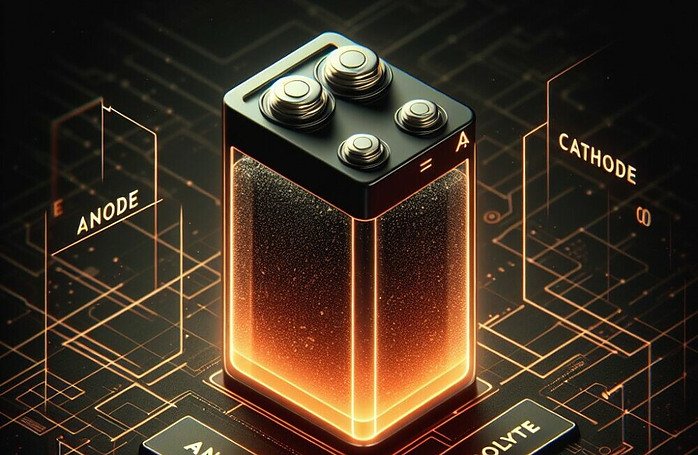In today’s rapidly evolving landscape, there is an unprecedented global shift towards sustainable energy solutions. This shift is driven by the urgent need to address climate change and reduce dependence on finite fossil fuels. Governments, industries, and consumers are actively seeking alternatives that diminish environmental impact while meeting escalating energy demands. In response to this imperative, transformative technologies are emerging, with Solid-State Batteries (SSBs) standing out as pioneers in reshaping the power storage landscape.
In the following sections, within the content of ‘Solid State Batteries Explained,’ we explore the definition, safety advantages, challenges, key considerations, and potential impacts of solid-state batteries on various industries.
What is a solid-state battery?
A solid-state battery is an innovative energy storage solution that replaces traditional liquid electrolytes with a solid counterpart, typically made of ceramics or glass-like materials. This design ensures enhanced safety by minimizing the risk of leakage and increasing resistance to temperature changes and physical damage. The solid-state battery operates by facilitating ion conduction between the anode and cathode through a solid electrolyte, offering a more efficient and safer alternative to conventional battery technologies.
Why are solid-state batteries considered safer?
Solid-state batteries stand out as a safer alternative to traditional counterparts, offering several key safety advantages:
1: Reduced Leakage Risk: Solid-state batteries eliminate the risk of electrolyte leakage, a common concern with traditional batteries. The use of a solid electrolyte ensures a sealed and stable structure, enhancing overall reliability. The absence of liquid components not only prevents potential environmental harm but also safeguards the internal components from damage due to leakage, contributing to a more robust and dependable energy storage solution.
2: Enhanced Durability: Solid-state batteries exhibit superior durability, particularly in resisting temperature fluctuations and physical stress. The solid electrolyte provides stability in varying environmental conditions, ensuring stable performance even in challenging circumstances. This durability minimizes the risk of damage during handling, transportation, and operation, making solid-state batteries a reliable choice for applications where resilience is paramount.
3: Lower Flammability: One of the standout safety features of solid-state batteries is their lower flammability compared to traditional counterparts. The absence of volatile liquid components significantly reduces the risk of fires, making solid-state batteries inherently safer, especially in applications with heightened fire hazard concerns. This characteristic is crucial in scenarios where safety is paramount, such as in electric vehicles and portable electronic devices, ensuring a more secure and trustworthy energy storage solution.
Challenges in Solid-State Battery Development
1: Complex Manufacturing Processes: The production of solid-state batteries involves intricate and often complex manufacturing processes. Integrating solid electrolytes, typically ceramic or glass-like materials, into battery cells requires precision and advanced techniques.
6: Material Costs: The cost of solid-state batteries is primarily driven by high-performance ceramics, lithium-ion conductors, and specialized glass-like materials. These components, crucial for efficient ion conduction and safety, contribute significantly to the overall expenses. The use of these advanced materials poses a challenge for manufacturers seeking to enhance the economic viability of solid-state batteries.
3: Production Scale: Scaling up production to meet the increasing demand for solid-state batteries poses a considerable challenge. Achieving economies of scale while maintaining consistent quality is crucial for reducing costs and making these batteries commercially viable.
4: Scalability Issues: As the demand for solid-state batteries grows, scaling up production without compromising performance becomes a technological hurdle. Ensuring uniformity and reliability across large-scale manufacturing processes remains a complex task.
5: Temperature Sensitivity: Solid-state batteries can be sensitive to temperature variations. Maintaining optimal operating temperatures is essential for their performance and longevity. Developing effective thermal management systems to address temperature concerns is an ongoing technological challenge.
Key Definitions in Solid-State Batteries

1: Anode: The negative electrode in a battery where oxidation occurs. In solid-state batteries (SSBs), it facilitates ion flow during electrochemical reactions.
2: Cathode: The positive electrode where reduction occurs. In SSBs, the cathode is vital for energy storage processes.
3: Electrolyte: A substance producing an electrically conducting solution when dissolved. In SSBs, the electrolyte, usually solid, conducts ions between the anode and cathode, contributing to safety and performance.
This post contains affiliate links. Thank you for supporting BeamBound and helping us continue creating great content—at no extra cost to you!
Solid State Advantage
1: Enhanced Efficiency: The adoption of a solid electrolyte in solid-state batteries significantly improves ion conduction. This advancement enhances the overall efficiency of the battery, minimizing energy losses during the charging and discharging processes. The solid electrolyte promotes more effective ion movement between the anode and cathode, optimizing the battery’s performance.
2: Improved Safety Features: Solid-state batteries introduce heightened safety measures by mitigating common risks associated with traditional batteries. The absence of a liquid electrolyte reduces the risk of leakage, contributing to a more secure and reliable energy storage solution. Moreover, solid-state batteries exhibit lower flammability, enhancing their safety profile. The increased resistance to temperature changes and physical damage further ensures the robustness of the battery in various operating conditions.
3: Extended Lifespan and Increased Energy Density: The solid-state design of these batteries plays a pivotal role in enhancing their lifespan. The absence of a liquid electrolyte minimizes issues related to electrolyte degradation over time, resulting in a more durable and long-lasting energy storage solution. Additionally, the potential for increased energy density means that solid-state batteries can store more power in a compact space, offering a higher energy-to-volume ratio compared to traditional batteries.
4: Faster Charging Times and Environmental Sustainability: Solid-state batteries revolutionize charging times while maintaining safety standards. The improved efficiency in ion conduction enables faster charging without compromising safety. Furthermore, the eco-friendly composition of solid-state batteries aligns seamlessly with sustainability goals, reducing the environmental impact of energy storage solutions. This dual focus on speed and sustainability positions solid-state batteries as a compelling choice for the future of energy storage, meeting the demands of efficiency, safety, and environmental consciousness.
Advancing Solid-State Battery Research: Unveiling Potential Breakthroughs through Collaborative Endeavors
1: Ongoing Research Initiatives: Researchers worldwide are actively engaged in addressing the challenges faced by solid-state batteries. Ongoing studies focus on refining manufacturing techniques, exploring new materials, and enhancing overall battery design.
2: Potential for Breakthroughs: The field of solid-state battery research holds great promise for breakthroughs that could overcome existing challenges. Innovations in materials science, battery architecture, and manufacturing processes may lead to significant advancements, making solid-state batteries more cost-effective, scalable, and commercially viable.
3: Collaborative Efforts: Collaboration between academic institutions, research organizations, and industry players is crucial for fostering innovation in solid-state battery technology. Joint efforts can accelerate the pace of discovery and facilitate the translation of research findings into practical applications.
The Role of Solid-State Batteries in the Future of Renewable Energy

1: Integration with Renewable Energy Systems: Solid-state batteries could play a pivotal role in energy storage systems connected to renewable sources like solar and wind. Their ability to store and release energy efficiently can help address the intermittent nature of renewable power generation, ensuring a more stable and reliable supply of clean energy.
2: Grid-Level Energy Storage: Large-scale deployment of solid-state batteries in grid-level energy storage facilities can contribute to energy grid stability, enable better management of peak demand, and facilitate the integration of renewable energy into existing power infrastructure.
3: Evolution of Consumer Electronics with the Adoption of Solid-State Technology: Consumer electronics, such as smartphones, laptops, and wearables, stand to benefit from the adoption of solid-state batteries. The improved energy density can lead to longer-lasting devices, reduced charging times, and enhanced overall performance.
4: Safety and Environmental Impact: The safety features of solid-state batteries, including reduced flammability and resistance to leakage, make them attractive for use in portable electronic devices. Additionally, their environmentally friendly composition aligns with the growing demand for sustainable and eco-friendly technologies.
5: Stimulating Innovation: The development and widespread adoption of solid-state batteries can stimulate innovation across various industries. Companies investing in research and development for solid-state technology may gain a competitive edge, fostering a culture of continuous improvement.
6: Job Creation and Economic Growth: As the solid-state battery industry expands, it has the potential to create new job opportunities and contribute to economic growth. This growth could extend beyond manufacturing to encompass research, development, and the establishment of a robust supply chain.
In summary, solid-state batteries represent a promising future for energy storage. Despite challenges in manufacturing and scalability, their enhanced safety and efficiency make them crucial for renewable energy integration and consumer electronics. Ongoing research offers hope for overcoming obstacles, and the widespread adoption of solid-state batteries holds potential for innovation, job creation, and economic growth. These batteries are poised to usher in a cleaner, safer, and more efficient era in energy storage.
Your comments and insights fuel exploration, shaping our understanding of the innovative frontier represented by solid-state batteries.






